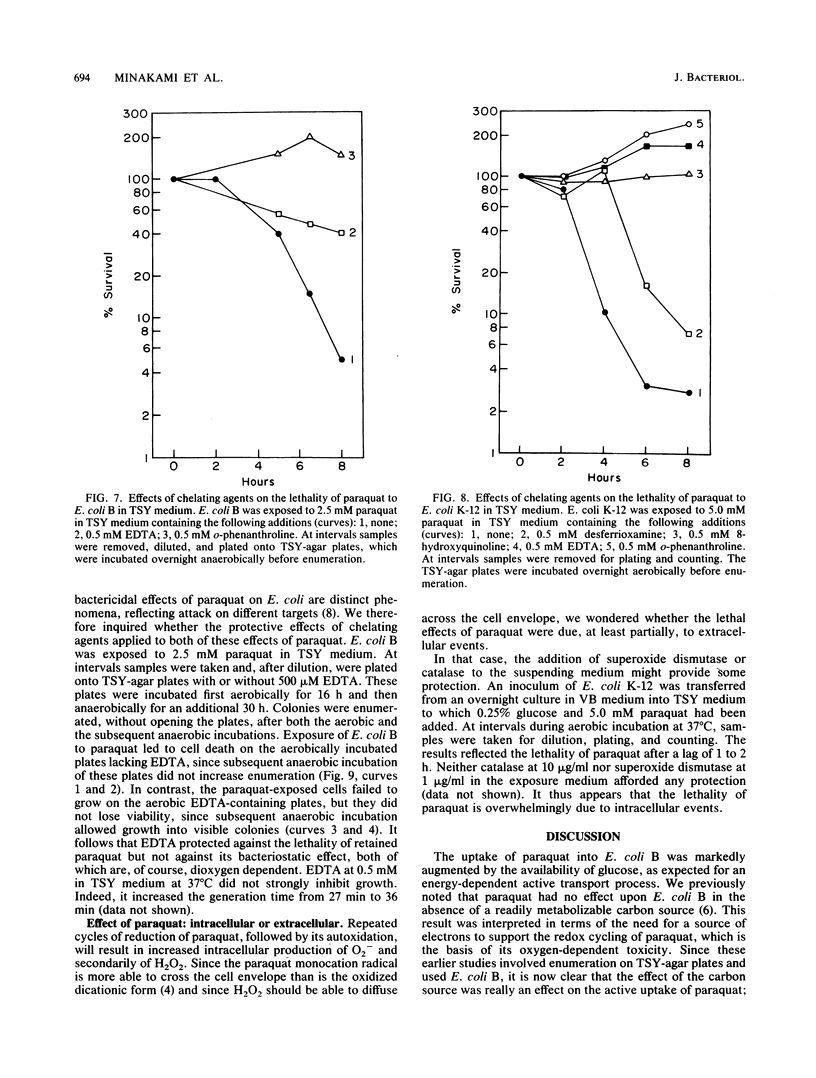Abstract
Retention of paraquat by Escherichia coli B was greatest after exposure at pH 9.0 and was progressively less after exposure at pH 7.0 and 5.0, respectively. This retained paraquat was capable of persistent growth inhibition. Uptake and retention of paraquat by E. coli B was dependent upon a carbon source, such as glucose. Under comparable conditions E. coli K-12 did not retain paraquat. The lethality of paraquat was seen in TSY medium but not in VB medium. The addition of Soytone, tryptone, or yeast extract, to the VB medium allowed the lethality of paraquat to be seen. A variety of chelating agents, including EDTA, 8-hydroxyquinoline, and o-phenanthroline, prevented the lethal effect of paraquat in TSY medium. Although EDTA protected against the lethality of paraquat, it did not protect against its bacteriostatic effect.
Full text
PDF




Selected References
These references are in PubMed. This may not be the complete list of references from this article.
- Felle H., Porter J. S., Slayman C. L., Kaback H. R. Quantitative measurements of membrane potential in Escherichia coli. Biochemistry. 1980 Jul 22;19(15):3585–3590. doi: 10.1021/bi00556a026. [DOI] [PubMed] [Google Scholar]
- Fisher H. K. Paraquat is not bacteriostatic under anaerobic conditions. Life Sci. 1976 Aug 1;19(3):421–425. doi: 10.1016/0024-3205(76)90048-5. [DOI] [PubMed] [Google Scholar]
- Hassan H. M., Fridovich I. Regulation of the synthesis of superoxide dismutase in Escherichia coli. Induction by methyl viologen. J Biol Chem. 1977 Nov 10;252(21):7667–7672. [PubMed] [Google Scholar]
- Hassan H. M., Fridovich I. Superoxide radical and the oxygen enhancement of the toxicity of paraquat in Escherichia coli. J Biol Chem. 1978 Nov 25;253(22):8143–8148. [PubMed] [Google Scholar]
- Jones R. W., Gray T. A., Garland P. B. A study of the permeability of the cytoplasmic membrane of Escherichia coli to reduced and oxidized benzyl viologen and methyl viologen cations: complications in the use of viologens as redox mediators for membrane-bound enzymes. Biochem Soc Trans. 1976;4(4):671–673. doi: 10.1042/bst0040671. [DOI] [PubMed] [Google Scholar]
- Kao S. M., Hassan H. M. Biochemical characterization of a paraquat-tolerant mutant of Escherichia coli. J Biol Chem. 1985 Sep 5;260(19):10478–10481. [PubMed] [Google Scholar]
- Kitzler J. W., Minakami H., Fridovich I. Effects of paraquat on Escherichia coli: differences between B and K-12 strains. J Bacteriol. 1990 Feb;172(2):686–690. doi: 10.1128/jb.172.2.686-690.1990. [DOI] [PMC free article] [PubMed] [Google Scholar]
- Kitzler J., Fridovich I. Effects of salts on the lethality of paraquat. J Bacteriol. 1986 Jul;167(1):346–349. doi: 10.1128/jb.167.1.346-349.1986. [DOI] [PMC free article] [PubMed] [Google Scholar]
- Kitzler J., Fridovich I. The effects of paraquat on Escherichia coli: distinction between bacteriostasis and lethality. J Free Radic Biol Med. 1986;2(4):245–248. doi: 10.1016/s0748-5514(86)80005-8. [DOI] [PubMed] [Google Scholar]
- Kohen R., Chevion M. Cytoplasmic membrane is the target organelle for transition metal mediated damage induced by paraquat in Escherichia coli. Biochemistry. 1988 Apr 5;27(7):2597–2603. doi: 10.1021/bi00407a049. [DOI] [PubMed] [Google Scholar]
- Kohen R., Chevion M. Transition metals potentiate paraquat toxicity. Free Radic Res Commun. 1985;1(2):79–88. doi: 10.3109/10715768509056540. [DOI] [PubMed] [Google Scholar]
- Korbashi P., Kohen R., Katzhendler J., Chevion M. Iron mediates paraquat toxicity in Escherichia coli. J Biol Chem. 1986 Sep 25;261(27):12472–12476. [PubMed] [Google Scholar]
- Padan E., Zilberstein D., Schuldiner S. pH homeostasis in bacteria. Biochim Biophys Acta. 1981 Dec;650(2-3):151–166. doi: 10.1016/0304-4157(81)90004-6. [DOI] [PubMed] [Google Scholar]
- Slonczewski J. L., Rosen B. P., Alger J. R., Macnab R. M. pH homeostasis in Escherichia coli: measurement by 31P nuclear magnetic resonance of methylphosphonate and phosphate. Proc Natl Acad Sci U S A. 1981 Oct;78(10):6271–6275. doi: 10.1073/pnas.78.10.6271. [DOI] [PMC free article] [PubMed] [Google Scholar]
- Yonei S., Noda A., Tachibana A., Akasaka S. Mutagenic and cytotoxic effects of oxygen free radicals generated by methylviologen (paraquat) on Escherichia coli with different DNA-repair capacities. Mutat Res. 1986 Oct;163(1):15–22. doi: 10.1016/0027-5107(86)90053-9. [DOI] [PubMed] [Google Scholar]
- Zilberstein D., Schuldiner S., Padan E. Proton electrochemical gradient in Escherichia coli cells and its relation to active transport of lactose. Biochemistry. 1979 Feb 20;18(4):669–673. doi: 10.1021/bi00571a018. [DOI] [PubMed] [Google Scholar]


